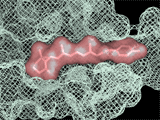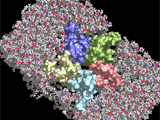
Chem 162/262
Drug Design

 |
Chem 162/262 |
 |
Dr. Kalju Kahn
Office: PSB-N 1511
Office hours: Tue 12:00-1:00, and Thu (12:30-1:30 PM) or by appointment
Phone: 893-6157
E-mail: kalju@chem.ucsb.edu
Website: http;//www.chem.ucsb.edu
To teach principles that govern the process of modern drug discovery and development. Students in the course follow a path similar to that taken by real-life drug developers by learning important elements of the drug design process in a logical order.
Lecture: MWF 12:00-12:50 Place: Phelps 1440
Computer Lab: Open day access Place: Chem 1153
| Syllabus | General information about the course. | |
| Textbook | The Organic Chemistry of Drug Design and Drug Action by Richard B. Silverman (Second Edition) | Amazon |
| Sample Lecture | Target Validation. (No Password Needed) Warning: Large File | PDF WAV |
| Year 2004 | Drug Desing (by Dr. Kalju Kahn) website for Spring 2004 | Link |
| Year 2003 | Drug Desing (by Dr. Norbert Reich) website for Spring 2003 | Link |
| Upload | Submit your assignments as MS Word or PDF files | Link |
| Exam | Exam Preparation Guide | |
| Exam Sample | Sample questions with answers from 2004 | |
| Poster Session | Some pictures from 2005 Student Poster Session | Link |
Course notes will be posted here before 7:30 a.m. of the lecture day. Lecture audio may be provided at a later date. These files are password-protected. Contact your instructor to obtain the password.
| Notes | Lecture Notes. Powerpoint Pages in PDF and Audio in WAV | Acrobat | Audio |
| Jan 3 | Overview of the course. History of drug design | WAV | |
| Jan 5 | Current trends and future of drug design. Diseases. | WAV | |
| Jan 7 | Target Validation | WAV | |
| Jan 10 | Target Validation | WAV | |
| Jan 12 | Enzymes as Drug Targets | WAV | |
| Jan 14 | Receptors as Drug Targets | No WAV | |
| Jan 19 | Enzyme Mechanisms | WAV | |
| Jan 21 | Enzyme Mechanisms and Kinetics | WAV | |
| Jan 24 | Enzyme Inhibition and Inactivation | WAV | |
| Jan 26 | Study of Receptors; Pharmacodynamics | WAV | |
| Jan 28 | Cell-based Assays: Lead Identification; Molecular Interactions | WAV | |
| Jan 31 | Binding thermodynamics; Structure-Based Drug Design | WAV | |
| Feb 2 | Structure-Based Drug Design | WAV | |
| Feb 4 | Structure-Based Drug Design: Docking and Visualization | WAV | |
| Feb 7 | Structure-Based Drug Design: Molecular Simulations | No WAV | |
| Feb 14 | Lead Modification: QSAR | WAV | |
| Feb 16 | QSAR, Medicinal Chemistry, Lead Modifications | No WAV | |
| Feb 23 | Combinatorial Chemistry | No WAV | |
| Feb 23 | Pharmacokinetics | No WAV | |
| Feb 25 | Drug Metabolism | WAV | |
| Feb 28 | Drug Metabolism | WAV | |
| March 2 | Prodrugs and Drug Delivery | No WAV | |
| March 4 | Nucleic Acid Drugs | No WAV | |
| March 7 | Pharmacogenomics | No WAV | |
| March 9 | Pharmacogenomics | No WAV | |
| March 11 | Pharmaceutical Industry: Jobs, Trends, and Outlook | No WAV |
| Literature | Required reading in PDF | Acrobat |
| General | From Serendipity to Rational Drug Design | |
| History | Drug Discovery: A Historical Perspective | |
| Future | Drug Research: Myths, Hype and Reality | |
| Future | Cell-based uHTS Chemical Genomic Drug Discovery | |
| Validation | Drug Discovery in the Post-Genomic Era | |
| Validation | DNA Microarrays | |
| Validation | mRNA Knockdown: Antisense, Ribozymes, RNAi | |
| Validation | Proteomics: Proteins Rule | |
| Targets | Protein Kinases as Drug Targets | |
| Enzymes | Enzyme Mechanisms: Transition State Binding | |
| Leads | HIV Protease Inhibitors | |
| SBDD | The Process of Structure-Based Drug Design | |
| SBDD | High-throughput docking | |
| SBDD | Nicotinic Acetylcholine Receptor: Docking | |
| ADME | Predicting Pharmacokinetics | |
| Gene Therapy | X-Linked SCID: Gene Therapy and Leukemia | |
| Antisense Therapy | Novel Antisense and PNA Strategies | |
| Pharmacogenomics | Better Therapeutics through Microarrays | |
| Protein Therapy | Preclinical safety of Biopharmaceuticals |
Suggested literature can be found now on a separate page
The assignments are posted one week before the due date. Answers shall be submitted electronically no later than the midnight of the due date.
| Assignments | PDF files | Acrobat |
| 0 | Drug Design Proposal Tips | |
| 1 | Target Validation | |
| 2 | Receptors and Enzymes as Drug Targets | |
| 3 | Enzymes: Mechanism and Inhibition | |
| 4 | Assay Development; Interactions and Thermodynamics | |
| 5 | Structure-Based Drug Design: Tutorial & Homework | Link |
| 6 | QSAR | |
| 7 | Drug Metabolism and Prodrugs | |
| 3-M | Enzymes: Mechanism and Inhibition (Make-up) |
The assignment keys are typically posted one week after the due date.
| Keys | PDF files | Acrobat |
| 1 | Target Validation | |
| 2 | Receptors and Enzymes as Drug Targets | |
| 3 | Enzymes: Mechanism and Inhibition | |
| 4 | Assay Development; Interactions and Thermodynamics | |
| 5 | Structure-Based Drug Design | |
| 6 | QSAR | |
| 7 | Drug Metabolism and Prodrugs |
Students in this course encounter many terms which have specific meaning in the context of drug design and medicine. You may find our glossary helpful when reading some of the assigned papers. If you encounter a term that is not in this dictionary, you could try a specialized medicinal chemistry glossary at www.chem.qmw.ac.uk/iupac/medchem ,an on-line dictionary at www.dictionary.com or an on-line encyclopedia at www.wikipedia.com . Feel free to send any additions and suggestions to Kalju Kahn
PyMOL Home Page
Biomolecular Images for Teaching with PyMOL
SYBYL Tutorial
Short List of Programs
Modern Drug Discovery
Nature Reviews Drug Discovery
Drug Discovery and Development
Drug Design Lecture Notes by Dr. Hugo Kubinyi
Oxford Drug Resistance Group Lectures
Basic Pharmacokinetics
Calcium Channel Blockers
Brain Chemistry
Acetylcholine Receptor
Online Video-Lectures
Dr. Andrew Boa lecture notes
An Overview of Marine Drug Discovery
Electronic Journals at UCSB
Google Web Search Engine
Biology Workbench
ExPASy Molecular Biology Server
Protein Data Bank
Periodic Table of the Elements
Cell and Molecular Biology Protocols Online
UCSB General Catalog
UCSB Campus Map
UCSB Gold Login
UCSB Umail Access
UCSB Environmental Health and Safety